How To Become a Data Analyst in Canada: An Essential Guide

quick answer
A Data Analyst reviews large amounts of data, identifies trends, and communicates those patterns to company stakeholders at all levels. To start your journey as a Data Analyst, get an education in a related field, learn basic technical skills like coding languages, and build a portfolio to share during the application process.
In This Article
Data is the backbone of all major business decisions today. It’s sourced, reviewed, and assessed to solve operational challenges and optimize performance. Poor data quality, however, can have a staggering financial impact. In fact, a recent study found that organizations lose an average of $12.9 million annually due to unreliable data.
That’s where a Data Analyst comes in: to help organize and parse all that data. With more than 16,000 Data Analyst jobs in active recruitment, you’re probably wondering how to become a Data Analyst in Canada.
If you’re considering a career as a Data Analyst, it’s important to understand the path it takes to get there. Here, we’ll unveil a roadmap for your journey by identifying the skills you’ll need, the tools you’ll use, and the seven essential steps you’ll take to become a Data Analyst. Read on to learn everything you need to know, from getting your education to nailing the job hunt, to begin your new career as a Data Analyst.
A Data Analyst is a sharp, inquisitive, and methodical thinker who evaluates large amounts of data, identifies larger trends, and communicates the significance of those patterns to company stakeholders at all levels. In essence, a Data Analyst is the heartbeat of any high-performing business and is one of the most in-demand roles in Canada today.
So what is a Data Analyst, exactly? This critical role provides visibility into company performance, offering an overview of trends that help leadership steer the ship and weather storms. Additionally, a Data Analyst provides business insights that:
If you’re considering a career in data analysis, you’ve likely heard about three core roles: Data Analyst, Data Engineer, and Data Scientist. But what purpose does each role serve, and how do they differ?
The most basic explanation is that an Analyst is generally considered an entry-level role, an Engineer is more mid-level, and a Scientist is the most senior-level role in the field with the most advanced skill set. As you progress in your career to higher-level roles, more sophisticated and complex skills are required to perform the duties of each function.
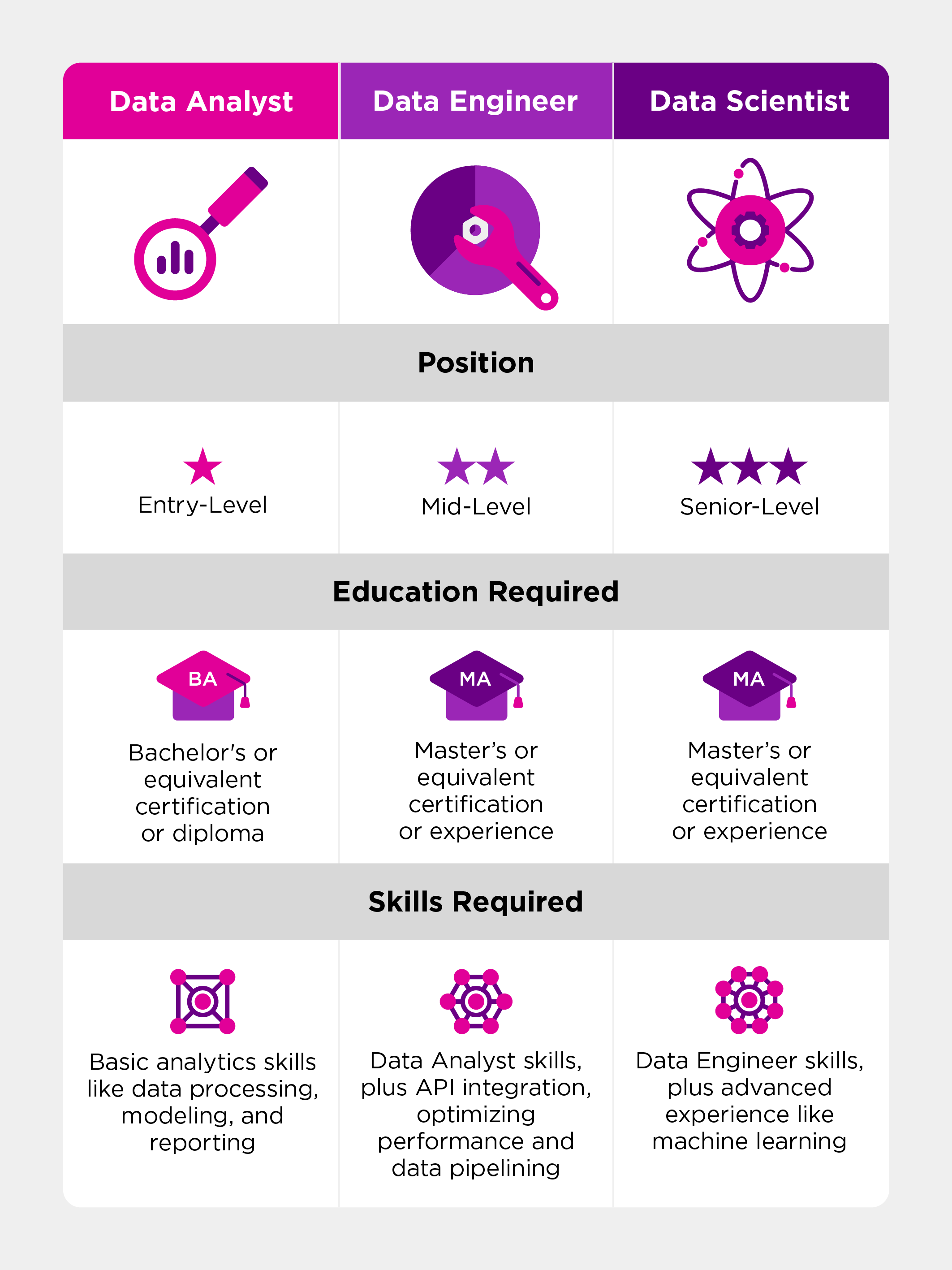
There are four main types of data analysis. The chart below explains each type’s tasks and how they’re applied to the daily duties of a Data Analyst.
|
Descriptive data analysis |
Analyzes what already happened |
Evaluates overall performance based on historical data |
|
Diagnostic data analysis |
Analyzes what already happened and why |
Evaluates how different factors contributed to a specific business outcome |
|
Predictive data analysis |
Data-backed analysis of what may or will happen |
Evaluates past performance to forecast future performance |
|
Prescriptive data analysis |
Data-backed recommendations on what to do next |
Evaluates many factors to recommend action and resolve a specific issue |
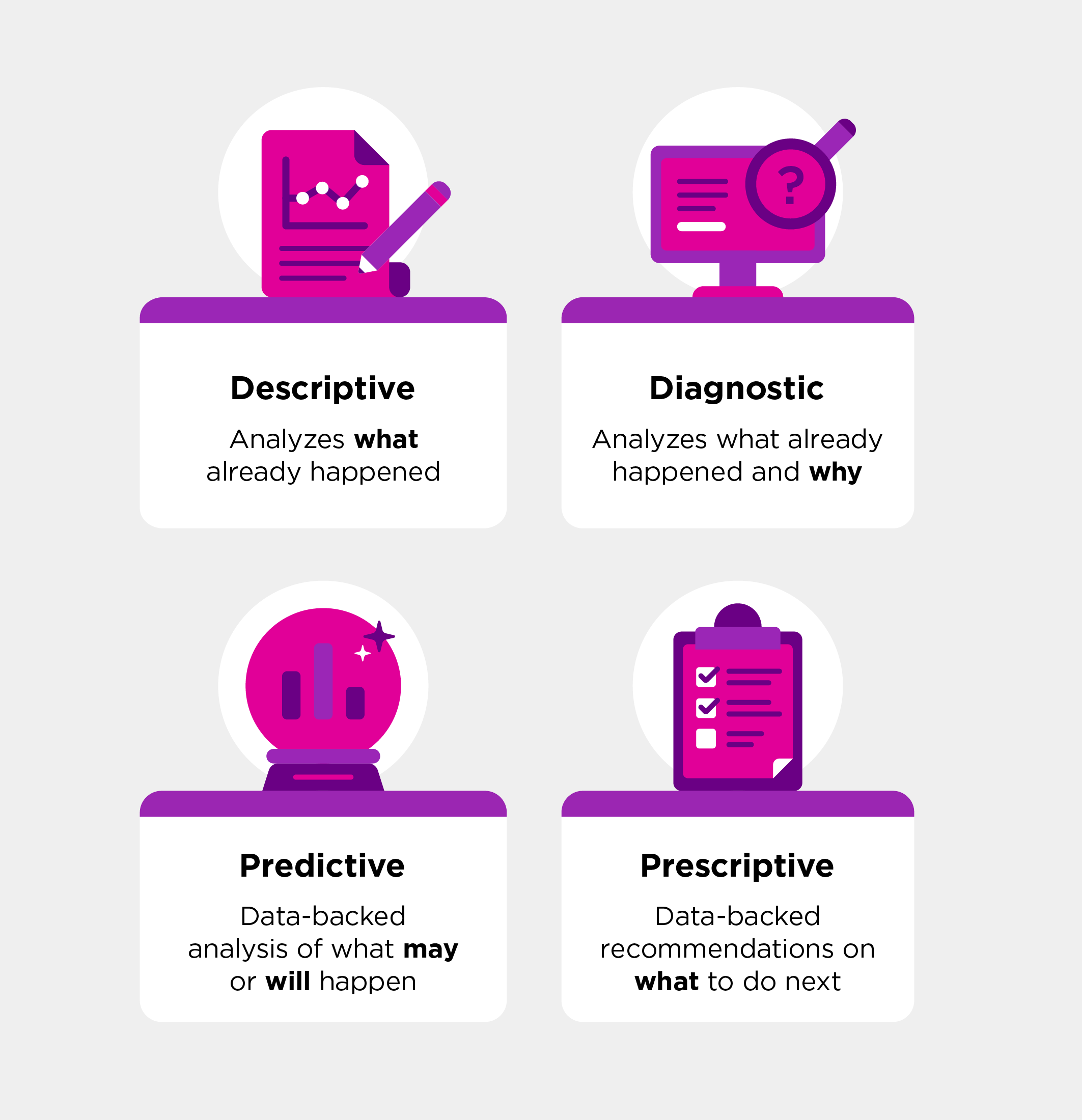
It can be intimidating to start a new career. Below, we break down the basic steps you can take to jump-start your new path.
For most Data Analyst positions, you’ll need to obtain a Bachelor’s Degree. Gaining a Degree in a related field of study, such as mathematics, computer science, or information technology (IT), can give you a leg up, with the average college program taking around four years to complete.
If you already have a Bachelor’s in an unrelated field, supplementary courses, like a Database Concepts course, can help you bolster your resume and land your first Data Analyst position.
Once you have the foundational knowledge, it’s time to get up-to-date on the technical skills you’ll use in your role. Brush up on computer languages such as XML and SQL. It’s helpful to have a basic understanding of a few different programming languages but choose one or two to specialize in.
If you earn a Bachelor’s Degree in a relevant field like computer science, you’ll learn these vital technical skills throughout your courses. Otherwise, you can take a Certificate course or teach yourself via online courses.
After learning the skills you need to become a Data Analyst, it’s time to demonstrate your working knowledge. You can find data sets online through government websites or other public data sources to run practice projects.
Try a variety of diagnostic, prescriptive, predictive, and descriptive projects to show your range and prepare yourself for different Data Analyst roles.
Portfolios are essential to landing your first Data Analyst role because they demonstrate your practical and technical skills. Choose projects that show a wider variety of your capabilities, and don’t be afraid to add practice projects.
Many Data Analysts create a personal website to platform their portfolio. Here, you can share your industry interests and skills with potential employers. GitHub and LinkedIn are two common hosting platforms for data analytics portfolios.
Online applications are a great way to start the job application process, but in-person connections are equally valuable. Networking is important to make connections, discover unlisted opportunities, and get valuable referrals for positions. Attend conferences and networking events, or even reach out to others on Linkedin to grow your network.
As a Data Analyst, you’ll be responsible for sharing your findings with team members who don’t have the same technical knowledge as you. It’s important to know how to break down your findings and communicate them in a digestible way. Key stakeholders don’t always have the best grasp on data, so good presentation skills allow them to actually follow your recommendations.
Now that you’ve done all the necessary preparation, it’s time to apply for your first Data Analyst position. There are a few strategies you can use to go about this:
Prepare your resume and portfolio and have them ready to share, whether you’re networking in person or applying online. When submitting a cover letter, ensure it’s personalized for each application based on the job posting and company you’re applying to. For the final touch, ensure you follow up on your job applications to show hiring managers you’re dedicated and reliable.
Post-graduate educational opportunities create a more desirable application and show potential employers that you’re always looking for opportunities to improve. If you’re new to data analysis, Degrees, Certificates, and Diplomas help bridge experience gaps when you’re trying to get your first job in a new field.
Especially in data analysis, there’s always something new to learn. Explore Robertson College’s micro-courses to expand your skills and put your best foot forward as a Data Analyst.
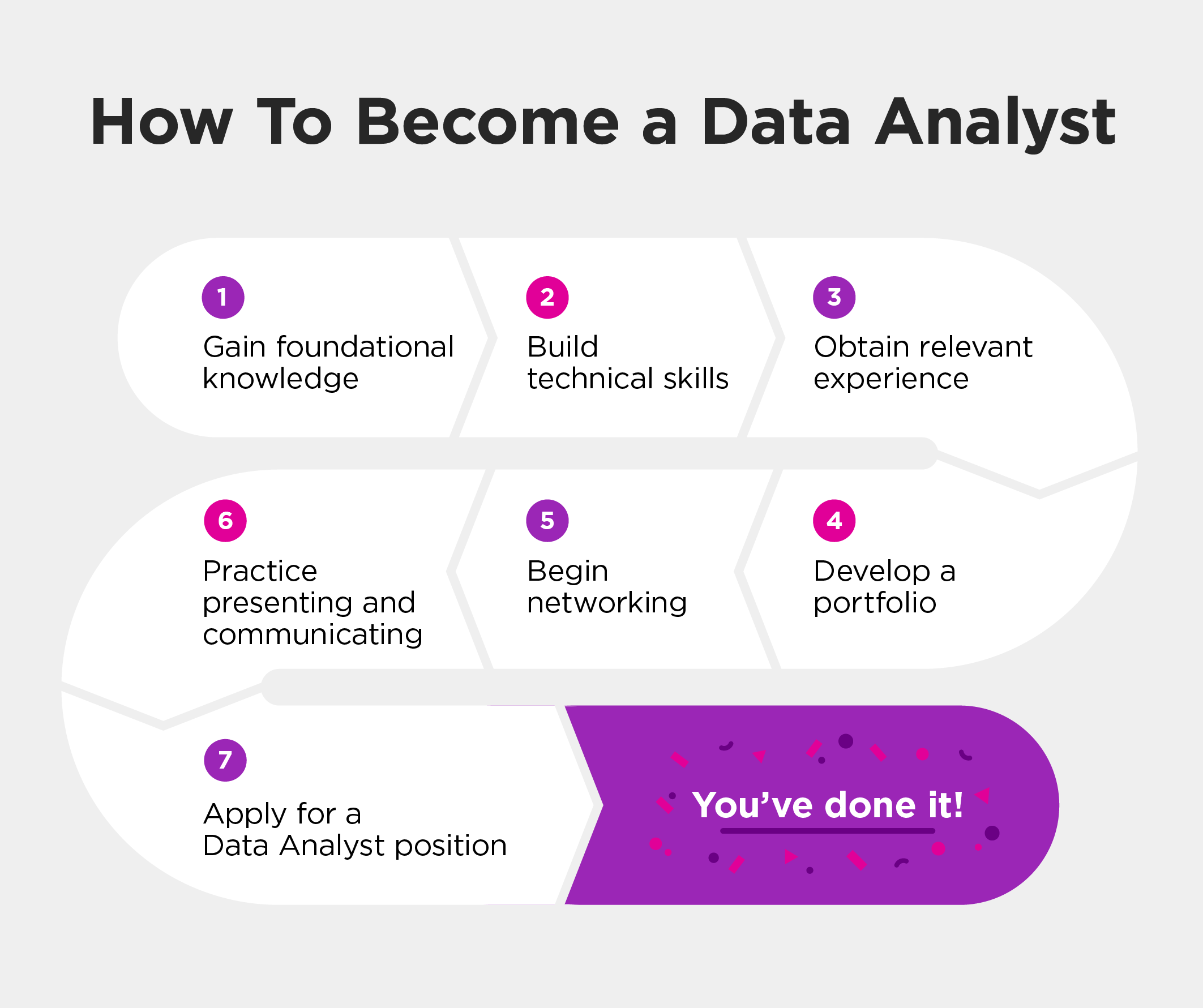
Data Analysts work in a variety of disciplines and industries, so the skills you need will be just as varied. Below are 17 in-demand Data Analyst skills — both technical skills and soft skills — that employers expect to see.
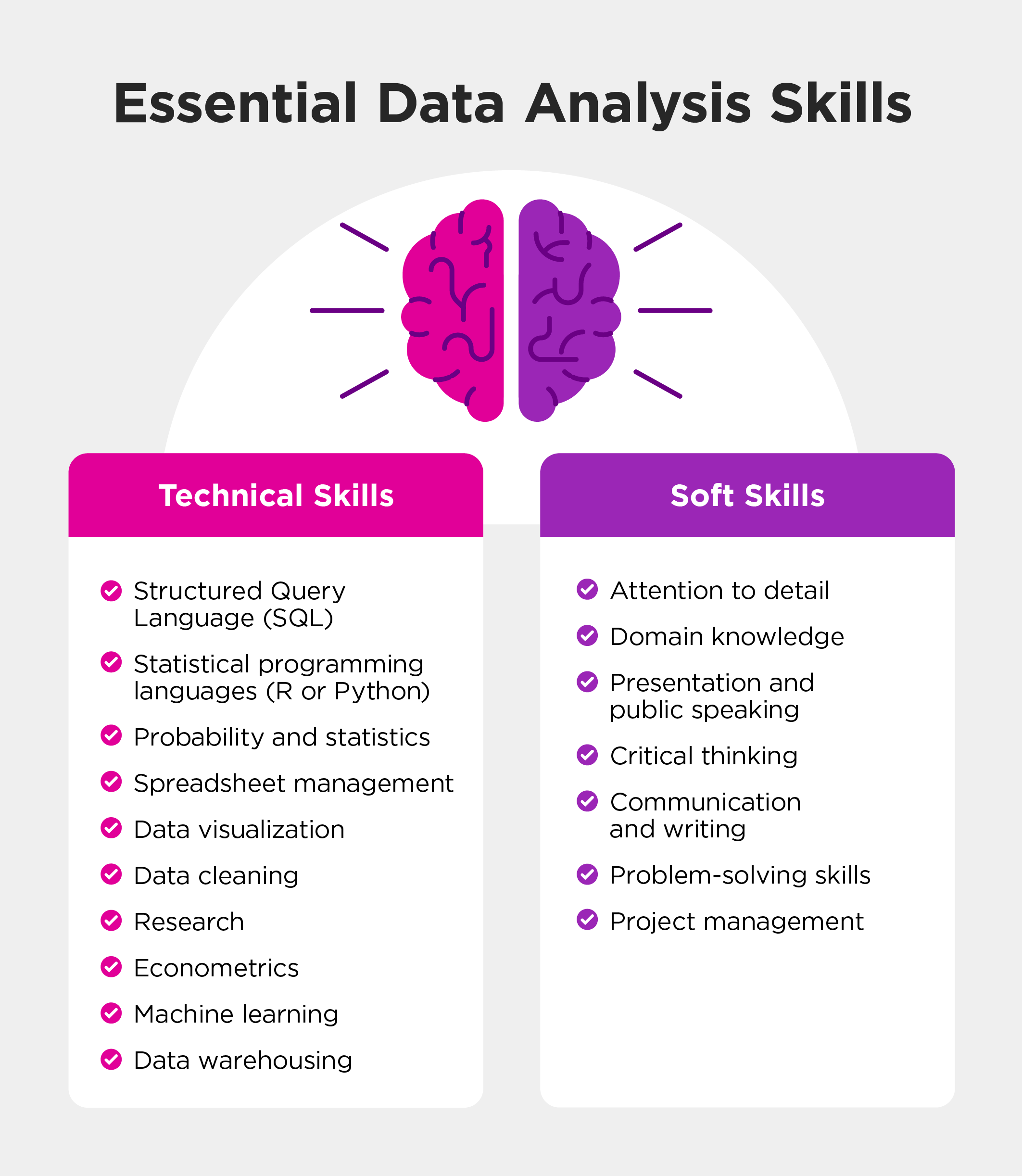
A command of SQL is widely considered the most important skill for a Data Analyst to have, as it’s recognized as the industry-standard database language. It’s also popular among businesses because it integrates well with other programs. At its core, SQL is a more robust version of Microsoft Excel, with the ability to process large-scale sets of data.
Type of skill: Technical
Similar to SQL, a basic description of R and Python is that they are more advanced versions of Microsoft Excel. Data Analysts commonly use them for their interactive, statistical environments that enable a more comprehensive analysis and visualization of data.
Type of skill: Technical
Processing data is an obvious skill set that any Data Analyst would need, but understanding models and conveying their meaning requires a completely different set of skills. Quintessential tasks that fall under probability and statistics include sampling and simulation as well as fostering in-depth knowledge of Regression and Bayesian models, loss functions, and time series.
Type of skill: Technical
Excel is one of the most widely used tools in business for good reason: Its nimble, relatively user-friendly interface enables professionals of all skill sets and abilities to leverage its tools. Where Data Analysts really shine with Excel is through more advanced functions like a VBA Lookup or writing macros.
Type of skill: Technical
Once a set of data has been mined, cleaned, analyzed, and reviewed, the next step for a Data Analyst is to illustrate those findings visually through elements like heat maps, charts, and graphs to understand trends and outliers. This is particularly useful when conveying findings to non-technical roles within an organization.
Type of skill: Technical
Data cleaning is a responsibility under data management where an analyst takes raw data and transcribes it to another form, such as a spreadsheet. Then, that data can be inserted into code or another tool and is analyzed more easily. A Data Analyst serves as the guardian of a company’s database, ensuring the suability, accuracy, and fidelity of that data.
Type of skill: Technical
A Data Analyst with research skills conducts studies to test hypotheses that inform business decisions and pivot points. While analyzing data involves reviewing and drawing conclusions, researching goes one step further to experiment with the data to test theories.
Type of skill: Technical
This skill is helpful across a variety of industries, but it’s especially relevant for those closely tied to the economy, like mining, agriculture, and manufacturing. Econometrics is the process of combining theory, math, and statistics principles to transform quantitative assessments into qualitative, actionable checklists that can help develop economic policy.
Type of skill: Technical
As a subset of artificial intelligence (AI) technology, machine learning is all about automating processes. As it applies to data analysis, it creates efficiencies within an analyst’s process by applying algorithms to replace slower, more manual work. This, in turn, shortens the time necessary to review large amounts of data and removes human biases from the process. The result? Comprehensive and objective insights revealed faster than a human is capable of producing.
Type of skill: Technical
Regarding business intelligence (BI) for companies, data warehouses are exactly what they sound like: a storage facility for housing information, from which dashboards and reports are subsequently created. It’s a veritable vault of intelligence that assists in making informed business decisions.
Type of skill: Technical
An errant decimal point, extra zero, or any other typo in a data set can have a massive ripple effect on subsequent data analysis, and there’s an ample opportunity for human error when parsing through large quantities of information. That’s why keen attention to detail is an essential skill in this role; making sure you’re checking (and double-checking) your work.
Type of skill: Soft
While nearly every industry needs Data Analysts, a general understanding of your specific field — otherwise known as domain knowledge — is essential. For example, a Business Intelligence Analyst for an auction software company should have a general understanding of how auctions are conducted and managed, how revenue is generated, and industry-specific terms.
Type of skill: Soft
Presenting findings clearly means honing presentation skills — like creating an organized deck in PowerPoint or Google Slides that visualizes your message, moves at an appropriate pace, and leaves the door open for answering questions.
Public speaking skills come naturally for some, but for others, it’s a muscle that needs to be flexed, only growing stronger with practice. Public speaking requires growing increasingly comfortable communicating with groups of all sizes.
Type of skill: Soft
This essential skill requires removing unconscious human bias — or “gut feeling” — to question the data and probe your findings with an objective approach to draw your conclusions. Critical thinking is important for Data Analysts because their analysis drives important decisions. It’s important to evaluate multiple perspectives and consider all possibilities as a Data Analyst to draw better conclusions.
Type of skill: Soft
Part of the role of a Data Analyst is to draw conclusions based on visible data trends, and being a strong communicator is an essential part of conveying those conclusions. Effective written and verbal communication skills are vital in this role to storytelling in a clear, thoughtful way, both in reporting and in conversation.
Type of skill: Soft
A Data Analyst is, by nature, a problem-solver at heart, with the ability not only to uncover opportunities for performance improvement but also serve up data-backed recommendations and opportunities to adjust or pivot processes in the future.
Type of skill: Soft
Building on attention to detail, strong project management skills are also essential in a Data Analyst role, as it requires the ability to collaborate and communicate cross-functionally to receive data requests and process them effectively.
Type of skill: Soft
At their core, Data Analysts are problem-solvers who can identify audience insights, diagnose performance issues, and drive revenue for a company. While no two days may be the same, the following are some of the most common daily tasks you’ll come across in this line of work as a Data Analyst:
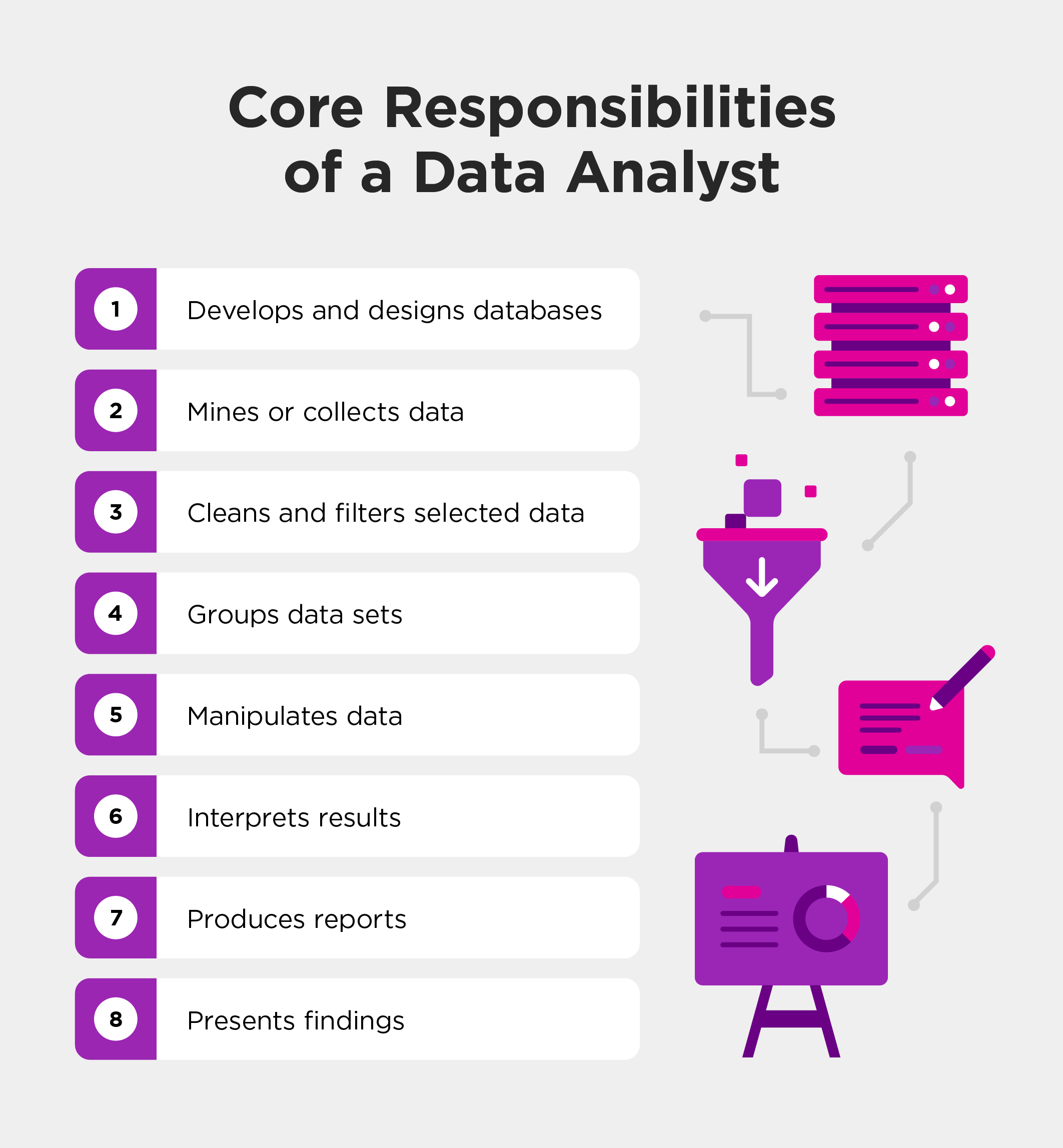
Data analytics jobs may vary across industries, so your role will look slightly different depending on whether you work at a financial institution, insurance company, or marketing agency. All types of organizations can benefit from having a Data Analyst who has an in-depth understanding of data and how to use it.
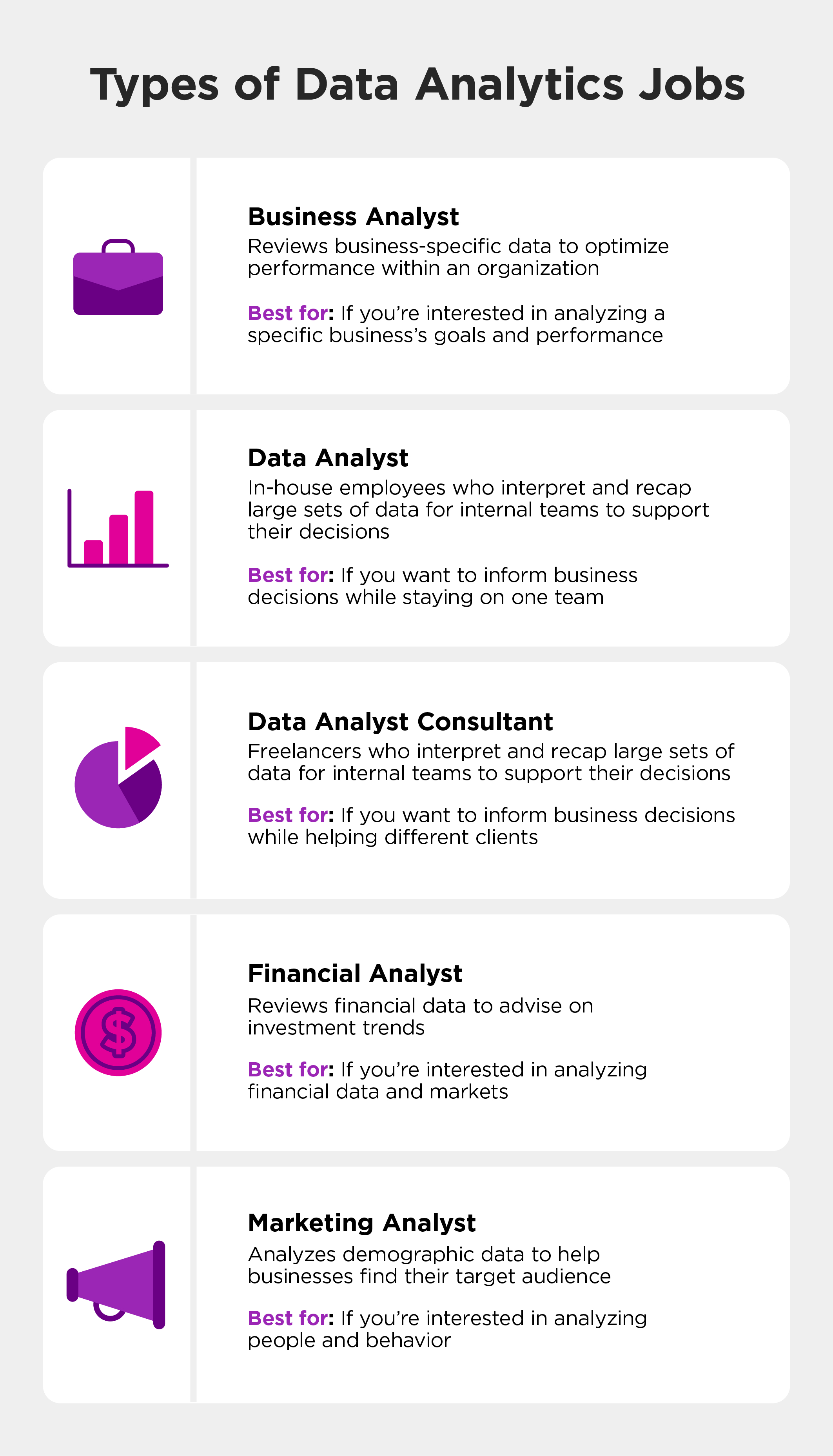
Business Analysts review business-specific data that can be used to optimize performance within an organization. They typically evaluate internal and external data for trends, successes, and any potential issues, then present their findings and recommendations for improvement to their teams.
Data Analysts gather large sets of data in order to interpret them, draw conclusions from them, and recap findings for internal teams. Analyzing data helps them make informed decisions, whether it’s about pricing products, cutting costs, readjusting budgets, or effectively reaching target audiences.
Data Analyst consultants are data problem-solvers. They’re responsible for presenting data insights, trends, and suggestions to organizations and advising them on how they can make stronger business decisions. The primary difference between a Data Analyst and a Data Analyst Consultant is they typically don’t work in-house. Instead, they may work for several organizations at one time and may have many different clients over their career.
Financial Analysts are one of the best-known types of data analytics jobs. The primary function of Financial Analysts is to look at financial data like stocks, bonds, mutual funds, and other investments. By evaluating investment performance, they’re able to better predict trends and advise businesses (or even individuals) on their financial decisions.
Marketing Analysts are people analysts — their goal is to help organizations better understand their target audiences so they can effectively reach them. They analyze data related to target demographics, including market research, purchasing trends, web traffic, and surveys, and use that data to determine how companies can better reach new and existing customers.
A large part of this job involves backing up the data and presenting it to other teams, so strong presentation skills are a bonus.
Are you still looking for some answers about what it’s like to become a Data Analyst in Canada? Read our expert responses to your top questions.
As of February 2024, the average base salary for a Data Analyst in Canada is $76,512, but that figure can vary based on location.
Given that many Data Analyst roles call for a Diploma or Bachelor’s Degree, it can take an average of three to four years to become a Data Analyst. However, that range can vary dramatically depending on specific requirements set forth by individual companies. At Robertson College, you can enroll in our Data Analyst program to earn your Diploma in just 12 months or earn our Data Analyst Advanced Diploma in 11 months.
According to the Government of Canada, the quality of the job market for Data Analysts over the next few years varies by province and territory:
In Canada, the typical route to becoming a Data Analyst includes gaining a Bachelor’s Degree in a relevant field of study, getting practical experience by learning coding languages, and demonstrating skills via your portfolio. These achievements will help when you begin networking and searching for a Data Analyst position.
If you don’t have a Degree, you can still become a Data Analyst. However, you would probably need to compensate for the lack of Degree. Some actions you can take to build out a more robust resume without a Degree include:
Becoming a Data Analyst in Canada is a promising career choice and can be the perfect fit for someone looking to start, level up, or change up their professional path. By enrolling in the right program, honing your technical skills, and networking, you’ll be starting your new job in a matter of months.
Ready to kick-start your career? Enroll in our Data Analyst program today.
In This Article
Once you take the first step, one of our Student Admissions Advisors will get in touch to better understand your goals for the future.
Apply Now